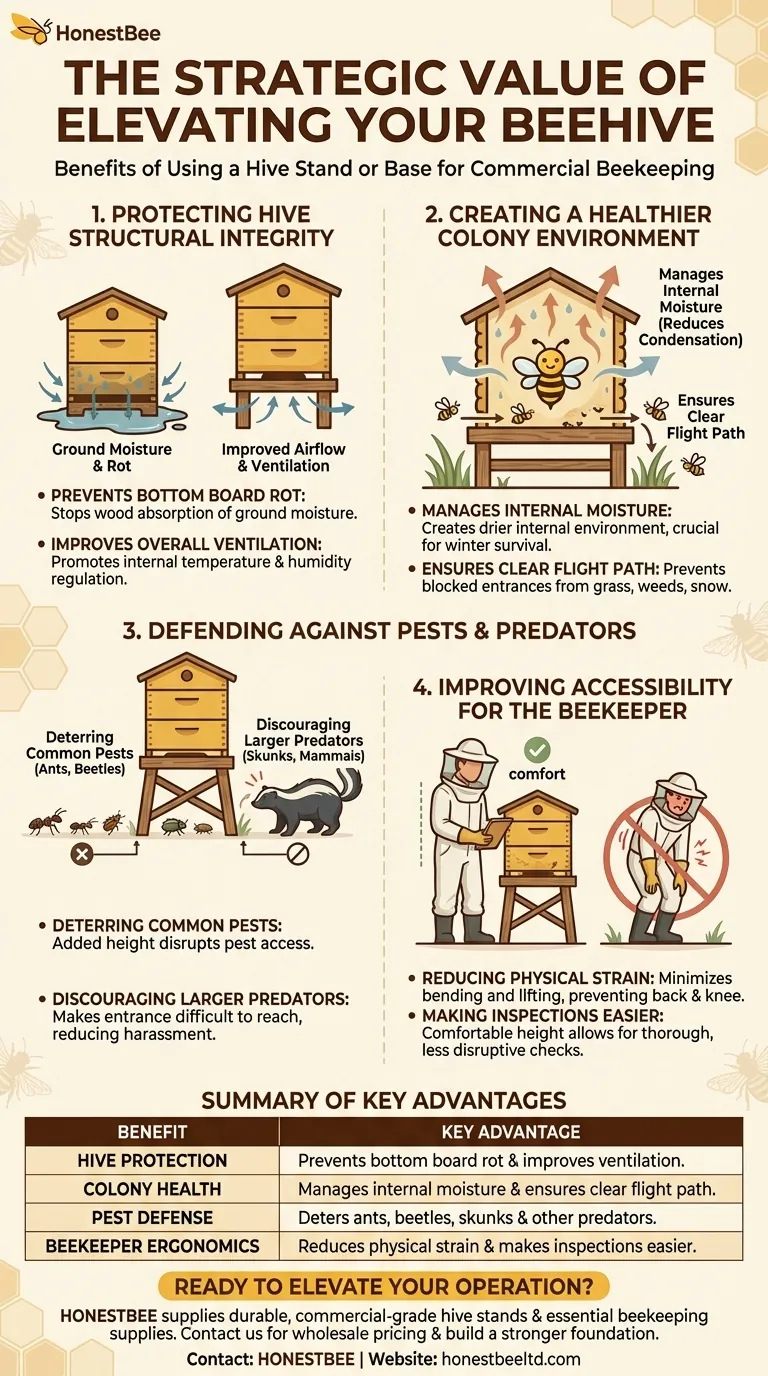Using a hive stand is a foundational strategy for successful beekeeping that elevates the colony both literally and figuratively. Elevating a hive prevents damaging ground moisture from soaking into the wooden components, protects the colony from pests, keeps the entrance clear for foragers, and significantly reduces the physical strain on the beekeeper.
A hive stand is not merely a piece of equipment; it is a strategic investment in the long-term health of your bee colony, the longevity of your hardware, and the sustainability of your beekeeping practice.

Protecting the Hive's Structural Integrity
A primary function of a hive stand is to protect the physical hive from the elements, particularly ground moisture. This separation from the earth has immediate and long-term benefits for the equipment itself.
Preventing Bottom Board Rot
The bottom board is the most vulnerable part of any hive. When placed directly on the ground, it constantly absorbs moisture, leading to mold, mildew, and eventually, wood rot.
Elevating the hive even a few inches creates an air gap. This airflow is critical for keeping the bottom board dry and dramatically extending its lifespan.
Improving Overall Ventilation
Proper air circulation is crucial for a healthy hive. A stand promotes airflow underneath the hive, which helps regulate internal temperature and humidity.
This improved ventilation complements the bees' own efforts to maintain a stable environment, reducing their workload.
Creating a Healthier Environment for the Colony
The benefits of elevation extend directly to the well-being of the bees inside. A dry, secure hive is a healthy hive.
Managing Internal Moisture
Bees generate a significant amount of moisture through respiration. When combined with ground dampness, this can lead to condensation inside the hive, especially during winter.
Cold, damp conditions are a primary cause of winter colony loss. By preventing ground moisture from entering the hive, a stand helps create a drier internal environment, increasing the colony's chances of survival.
Ensuring a Clear Flight Path
Placing a hive on the ground means grass, weeds, and falling snow can easily block the entrance. This obstructs the bees' foraging flights and defensive activities.
A hive stand keeps the entrance clear of ground-level obstructions, ensuring the bees can come and go efficiently.
Defending Against Pests and Predators
Elevation creates a simple but effective first line of defense against many common hive threats that travel along the ground.
Deterring Common Pests
Pests like ants and small hive beetles have a much harder time accessing a hive that is raised off the ground.
While not a complete solution, the added height disrupts their path and makes the hive a less accessible target.
Discouraging Larger Predators
Skunks and other small mammals often disturb hives at night, scratching at the entrance to coax out and eat guard bees.
Elevating the hive makes it more difficult for these predators to reach the entrance, reducing harassment and stress on the colony.
Improving Accessibility for the Beekeeper
Beekeeping involves regular inspections and lifting heavy boxes filled with honey. A hive stand is one of the most important ergonomic tools a beekeeper can use.
Reducing Physical Strain
Constantly bending over to inspect a hive on the ground puts significant strain on your back and knees.
A stand that raises the hive to a comfortable working height (around waist level) transforms the physical experience of beekeeping, making it more enjoyable and sustainable long-term.
Making Inspections Easier
Working at a comfortable height allows for more thorough and less disruptive inspections. You can observe the colony's health and perform necessary tasks without the physical discomfort of crouching on the ground.
Making the Right Choice for Your Apiary
A hive stand is a simple addition with a disproportionately large impact on your beekeeping success.
- If your primary focus is colony health and winter survival: Prioritize any form of elevation to ensure the hive stays dry and well-ventilated.
- If your primary focus is beekeeper comfort and ease of management: Choose a stand that raises the hive to your waist height to minimize bending and lifting strain.
- If your primary focus is pest and predator control: Select a taller stand, potentially with features like legs that can be placed in oil-filled cans to deter crawling insects.
Ultimately, elevating your hive is a fundamental step toward creating a safer, healthier, and more productive environment for your bees.
Summary Table:
| Benefit | Key Advantage |
|---|---|
| Hive Protection | Prevents bottom board rot and improves ventilation. |
| Colony Health | Manages internal moisture and ensures a clear flight path. |
| Pest Defense | Deters ants, hive beetles, skunks, and other predators. |
| Beekeeper Ergonomics | Reduces physical strain and makes inspections easier. |
Ready to elevate your beekeeping operation? HONESTBEE supplies durable, commercial-grade hive stands and other essential beekeeping supplies to commercial apiaries and distributors. Investing in the right equipment protects your investment in your colonies and your team's well-being. Contact HONESTBEE today to discuss wholesale pricing and how our equipment can build a stronger foundation for your business.
Visual Guide

Related Products
- Plastic Bee Hive Stand for Beekeeping
- Professional Engraved Round Hive Number Tags for Beekeeping
- Professional Ant-Proof Beehive Stand with Integrated Moat for Beekeeping
- Metal Hive Feet Bee Hive Stand for Ant Protection
- Metal Bee Hive Stand Bee Box Stand for Beekeeping
People Also Ask
- How do bees regulate ventilation and temperature in the hive? Master Hive Climate Control
- Why is elevating the hive important? A Simple Step for a Healthier, More Productive Colony
- What are the main differences between Langstroth and Top Bar Hive designs? Choose the Right Hive for Your Beekeeping Goals
- What are the advantages of a second hive if the queen is killed? The Ultimate Insurance Policy for Your Apiary
- What is the purpose of a hive stand in a Langstroth hive? Protect Your Hive and Boost Colony Health



















